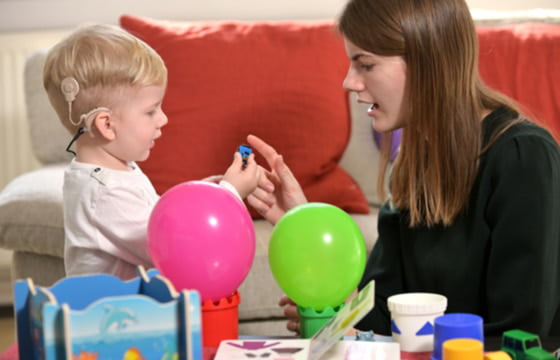A Parent’s Guide To Understanding Vision Problems for Children With Disabilities

Vision problems are a serious issue for anyone who has them, especially children. This is even more so the case for children with disabilities. A review of the subject by Drs. Alison Salt and Jenefer Sargent published by the National Institutes of Health (NIH) states, “Children with disability are at a substantially higher risk of visual impairment (10.5% compared with 0.16%) but also of ocular disorders of all types, including refractive errors and strabismus.”
For children with disabilities, however, not only are vision problems more common, but they also present specific difficulties in diagnosing visual impairment. According to Optometrists Network, “research also shows that an even higher percentage of children with special needs may have vision problems that are undiagnosed because their associative behaviors are perceived as part of their special needs diagnosis.”
For parents, understanding the relationship between vision problems and disabilities in children is incredibly important to best help their children succeed in everything they do.
Common Visual Disorders Among Children With Disabilities
There are several types of common visual disorders among children with disabilities that are seen at a much higher rate than among the general population.
Here are some of the most common visual disorders among children with disabilities, according to the NIH study linked above:
- Cerebral visual impairment (CVI): CVI is a spectrum of visual impairments characterized by visual difficulty occurring within the context of a normal ocular exam.
- Nearsightedness (Myopia): Nearsightedness has been shown to be present in much higher rates among children with disabilities (11-16% among children with an intellectual disability, 13% among those with Down Syndrome, 46.6% of those with cerebral palsy, and between 10-18.9% among those born preterm), as compared to the general population (1.39%).
- Farsightedness (Hyperopia): Similarly to myopia, farsightedness has been shown as present among children with disabilities at a higher rate (24% among those with intellectual disability and 10.2% among those with cerebral palsy), as compared to the general population (0.9%).
- Optic atrophy: Optic atrophy is a condition affecting the optic nerve that carries information between the eye and the brain and is second only to CVI as the most common visual impairment among children with learning difficulty.
- Retinal dystrophies: Retinal dystrophies are a group of diseases that damage the retina and are a more common visual impairment among children with learning difficulty as compared to the general public.
- Congenital nystagmus: Congenital nystagmus is a rapid and involuntary vertical or horizontal shaking movement of the eyes present typically starting between 6 months and several months of birth and is common among children with learning difficulty.
- Cataracts: Cataracts occur when the natural lens of the eye becomes cloudy, causing vision to blur over time. Even though cataracts are overall uncommon in children, they are possible, and about 25% of congenital cataracts have a genetic cause, including disabilities such as Down syndrome, and in a limited study, congenital cataracts were very commonly shown to be comorbid with a variety of disabilities.
- Refractive errors: Refractive errors are a type of vision problem that makes it hard to see due to light not focusing correctly on your retina and are abundantly more common among children with disabilities as compared to the general public (44% among those with intellectual disability, 55% among those with Down Syndrome, 60% among those with cerebral palsy, and 19% among those born preterm, as compared to 4.5% among the general population).
- Strabismus: (27% among those with intellectual disability, 25% among those with down syndrome, 59% among those with cerebral palsy, and as high as 44% born preterm, as compared to as high as 7.5% of the general population).

What Are the Leading Causes of Vision Problems in Children With Disabilities?
Eye health is often impacted by other health conditions, especially among children with disabilities.
Again, according to Drs. Salt and Sargent, “The higher prevalence of visual disorders in children with developmental disabilities is accounted for by the many underlying causes of their disability with prenatal and perinatal factors and acquired injury all of relevance. Therefore, visual disorders are particularly increased in children born preterm, children who have suffered brain-damaging events with subsequent learning difficulty and/or cerebral palsy, and children who have congenital cerebral anomalies or other genetic syndromes that may predispose to ocular anomalies. Children who have primary visual disorders may also be at risk of later disability.”
According to the NIH study linked above, here are the most common causes of vision problems in children with disabilities and the visual impairments most often connected with them:
- Children Born Preterm: cerebral visual impairment, retinopathy of prematurity, refractive errors.
- Cerebral Palsy: visual impairments from severe motor impairment, abnormalities of eye movement, reduced acuity, refractive errors, strabismus, oculomotor abnormalities, visual field alterations, weakness in visual object recognition, visuospatial skills, visual memory, oculomotor control.
- Following a brain injury: a wide spectrum of vision problems typically characterized by reduced visual acuity, subnormal visual performance, and evidence of damage to the posterior visual pathways.
- Learning Difficulties: prevalence of visual impairment among children with learning difficulty is as much as 10 times higher than the general population, most commonly optic atrophy, retinal dystrophies, congenital nystagmus, refractive disorders, and strabismus.
- Down Syndrome: refractive errors, reduced accommodation, strabismus, blepharitis, nasolacrimal duct problems, congenital or acquired cataracts, and keratoconus.
- Severe hearing impairment: dual sensory impairment, ocular coloboma, retinal coloboma, retinal detachment, and corneal injury.
- Visual impairment leading to disability: regression in cognitive development often from disordered social communication and/or autistic spectrum disorder.
Why Are Vision Problems in Children With Disabilities Sometimes Overlooked?
According to the same review by Drs. Alison Salt and Jenefer Sargent, “[Visual impairments] and other potentially correctable ocular disorders may not be recognised without careful assessment and are frequently unidentified in children with complex needs. Although assessment may be more challenging than in other children, identifying these potential additional barriers to learning and development may be critical.”
The added complexity and challenges that disabilities often present across the board for children with disabilities also, unfortunately, have a negative impact on the diagnosis of vision problems. This is because the child may not be able to fully express or comprehend the impact their vision problems have on them, or these vision problems are grouped with other signs and symptoms of their disability.
Common Symptoms of Vision Problems in Children With Disabilities
While the following symptoms are not inherent to vision problems in children with disabilities, they are common signs that are worth paying attention to.
- Verbal:
- Skipping or repeating lines when reading.
- Omission of small words when reading.
- Physical:
- Tilting of the head and/or closing of one eye when reading.
- One eye turns in or out.
- Difficulty copying from the classroom whiteboard.
- Holding reading material extremely close.
- Has especially poor handwriting.
- Commonly displaying clumsiness and/or knocking things over.
- Frequently suffering car and/or motion sickness.
- Displaying of unusual neck and body postures.
- Suffering from uncontrolled eye shaking (Nystagmus).
- Cognitive:
- Displaying poor reading comprehension.
- Difficulties completing homework.
- Reduced attention to visual stimuli.
- Trouble maintaining attention when reading.
- Unable to maintain simultaneous attention on visual and auditory stimuli.
- Facing difficulties related to visual perception.
Special Considerations for Diagnosis
There are special considerations for the diagnosis of vision problems in children with disabilities that parents need to know. Due to certain behavioral, psychological, and physical traits of children with disabilities, vision problems commonly go undiagnosed and/or unnoticed due to symptoms getting conflated with other disability symptoms.
- Movement during diagnostic procedures: this can prevent accurate diagnoses if/when a procedure requires the child to remain still.
- Inability to communicate vision problems: some children with disabilities may not be able to fully communicate vision problems they are experiencing.
- Inability to comprehend severity or difference of vision problems: some children with disabilities may not be able to fully understand that their vision is experiencing problems or that they have any reason to be concerned.
- Fear or anxiety of strangers/doctors: some children with disabilities experience social anxieties or difficulties and may fear doctors or strangers involved in the diagnosis process.

Special Considerations for Treatment
Special considerations for children with vision problems and disabilities go beyond diagnosis and are also an important factor in treatment as well.
Some special considerations you may need to make when treating vision problems in a child with disabilities include:
- Discomfort with corrective eyewear: If a child with a disability feels uncomfortable wearing their corrective eyewear, it can present difficulties in providing them with the best treatment and support both to correct their vision problems as well as providing the support needed for their disability. Special consideration should be taken to ensure they are comfortable wearing them. Sometimes this can be as direct as asking them if they are comfortable or not because they may not otherwise communicate about their discomfort.
- Inability to express or fully understand vision problems: A child with a disability may not be able to fully understand or express the vision problems they are experiencing. Finding ways to communicate with them about their vision without being too general is important. For instance, if they are asked if their vision is fine, they may not realize that what they are experiencing is, in fact, a problem, and therefore say yes. However, try asking specific questions like if they can clearly see words on a classroom whiteboard or in a book held in front of them at a normal reading distance.
- Emotional Impact: Treatment for vision problems may impact a child with a disability more heavily than other children. For instance, they may fear wearing glasses, may be uncomfortable with their appearance wearing glasses, or may feel overwhelmed by the sensory change associated with their newly-corrected vision. It is vital for the child’s treatment to be aware of this possibility and be supportive of them emotionally.
- Responsibility: A child with a disability may struggle with the responsibility attached to taking care of their glasses. Whether they struggle to uphold this responsibility or suffer from anxiety due to it, it is important to be patient and work with the child to encourage successful behavior and habits.
Treatment Options and Goals
Depending on the specific vision problems children with disabilities face there are various treatment options and goals for those options available.
Common treatment options include:
- Same treatment as other children: in many cases, treatment of these vision problems for children with disabilities is the same as you would see for any child facing the same visual impairments. However, the special considerations mentioned above for both diagnosis and treatment are vital to ensure the child receives the best care and treatment possible. If a parent has concerns about the special considerations needed for their child they should discuss it with the ophthalmologist beforehand if possible. Discussing these concerns with the child’s existing pediatrician who understands the child’s needs and asking for a referral or recommendation to an ophthalmologist can also ease this process.
- LASIK Surgery: Though LASIK Eye Surgery is not approved for children under the age of 18, it is a potential future treatment for vision problems for children with disabilities once they are of age.
- Eye Exercises: While eye exercises may not medically correct serious vision problems, they are a great way to improve vision health and slow or prevent eye fatigue and strain over time, reducing long-term damage of some vision problems.
- Diet: While diet alone is not a treatment for vision problems, along with eye exercises, diet can be a great way to encourage vision health to reduce long-term damage and prevent vision problems from worsening over time due to the effects of a poor diet.
Resources for Parents
If you are the parent of a child with a disability that is experiencing vision problems, it is important to remember that there is no one answer for how to best handle every difficulty or challenge that comes your way except to approach every question and decision with love and your child’s best interest as motivation.
Further reading and other resources:
- “Common visual problems in children with disability” by Drs. Alison Salt and Jenefer Sargent: A scholarly review of the connection between children with disabilities and vision problems, current practices for diagnosis and treatment, and recommendations for improvements that could be made.
- “Getting Support When Your Child Has Special Health Care Needs” by Nemours KidsHealth, reviewed by Carrie Sewell-Roberts, LCSW: a guide for parents on how to get the support they need to ensure their child gets the best care possible.
- Vision Therapy for Special Needs – Optometrists Network: breakdowns of things you should know about the connections between vision health care and many types of disability and special needs.

